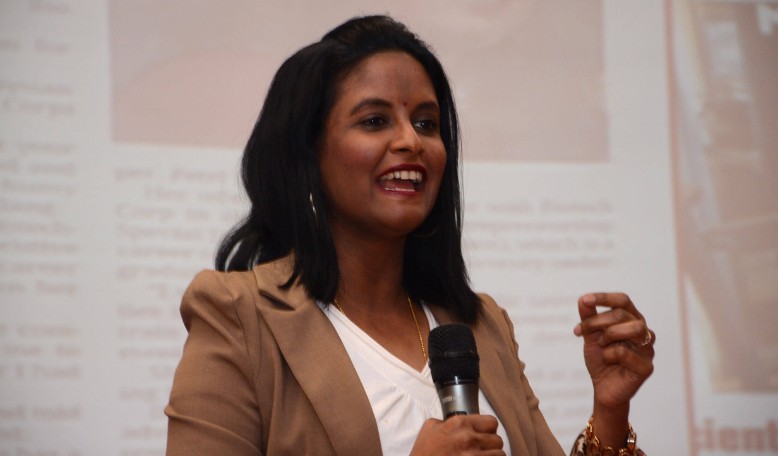Malaysian science communicator shed light on ‘COVID-19 Infodemic’


Executive Director of Malaysian Biotechnology Information Center (MABIC) delivered a speech on “Strategies for COVID-19 Infodemic Management” in the virtual STEP held on November 26.
MSTF Media reports:
The Mustafa Science and Technology Foundation (MSTF) held a virtual Science and Technology Exchange Program (STEP) in collaboration with ECO Science Foundation (ECOSF) on November 26.
Revolving around “National Policy and Institutional Framework for Health Communication”, this panel discussion convened distinguished experts in science communication from Pakistan, Malaysia, Iran, and Egypt.
As a participant of this virtual event, Mahaletchumy Arujanan, Executive Director of Malaysian Biotechnology Information Center (MABIC), addressed “Strategies for COVID-19 Infodemic Management.”
She talked about science communication, focusing chiefly on what the scientists are to do beyond R&D.
As she said, the term “infodemic was introduced by the WHO.”
At the beginning of the COVID-19 pandemic, there were so much “fake news, pseudoscience, and misinformation,” she elaborated.
All these, confused the public and prevented the authorities and front-line health-care workers from achieving the target of breaking the chain of transmission, Arujanan remarked.
This is not limited only to COVID-19 pandemic; in fact, infodemic, pseudoscience, and myths about science “have been there all the time,” she continued.
Arujanan asserted: “As a science communicator, I would say that scientists are still slow in addressing infodemic and pseudoscience.”
The current pandemic has been “a great teacher” which demonstrated the void in science communication. “This crisis made us see the consequences of not bridging science, scientists, and research with society,” she contended.
Echoing Sir Mark Walport who maintains ‘Science isn’t finished until it is communicated to wider audience,’ she stated that science communication is not only about attending international scientific conferences, but rather communicating science to “non-technical audience.”
“In many countries, especially the developing countries, this is not being done at the optimal level,” Arujanan observed.
She said there are a number of reasons which necessitate science communication, some of which are “economic, political, democratic, utilitarian, and cultural.”
For policies, regulations, and funding to support science and technology, scientists must communicate science, she said.
In many countries, policies and regulations are not science-based. In such environments, so many regulations “stifle emerging technologies” like nanotechnology, genetic modification, etc.
If scientists communicate science, “policy-makers make informed decisions,” she declared.
Referring to the current situation of COVID-19 vaccine availability, she said that the developing countries are depending on developed nations to buy the vaccine. In her words, “although vaccine development is not easy and takes times, we have the best brains in developing countries, but we have not put the policies, regulations and funding in the right place so that during the times of crisis we do not depend on other nations.”
She further hinted at other issues that emerged during the current pandemic. Arujanan said that COVID-19 pandemic has shown us how vulnerable many countries are when it comes to food security.
The supply chain was broken in COVID-9 pandemic, because “we did not put our priority in the right place,” she remarked.
According to her, if we communicate the important areas of science, the policies, regulations, and funding can be focused on the right area.
We also aim at having a “democratized science” so that it does not belong only to the scientific society. In other words, everyone should have some basic information about science so that they can influence policymaking.
“For example, the public can put pressure on the government to put funding on emerging diseases rather than unnecessary areas,” she continued.
Arujanan stated that we should “make science a culture.” Rather than the dominant culture of excessive shopping and eating in many countries nowadays, science must become a culture by “increasing scientific literacy and making science a hobby.”
Enumerating some traditional obligations of scientists, she said that some scientists wonder why they should communicate science in addition to doing the already-defined obligations.
She pointed to some of the advantages of science communication for scientists themselves, saying that scientists by communicating science can have industry collaborations, shape the policymaking according to their research, and get both crowd funding and angel funding needed for doing their research.
Moreover, “we need more civic scientists in developing countries” where scientists can be regarded as “role models and spokespeople,” so that people receive scientific news directly from the scientists rather than getting inclined towards pseudoscience and infodmeic.
Arujanan also stated that if the scientists publish their research in scientific journals, and at the same time in popular science, its reach will be wider as not only peers, but also “scientists in other areas, politicians, policymakers, people in industry, investors, and the public” will be able to read it.
She stressed that “during a crisis such as COVID-19, increasing the awareness of all these groups becomes even more important.”
“However, we cannot use the same language and the same examples when we want to communicate science to different groups,” she underlined.
Communicating science to different sectors, in Arujanan’s words, requires “completely different approaches; we need to customize the messages, strategies, and tools.”
Mahaletchumy Arujanan, Global Coordinator of International Service for the Acquisition of Agribiotech Applications (ISAAA); co-founder of Science Media Centre Malaysia; and founder and editor-in-chief of The Petri Dish, the first science newspaper in Malaysia, further said: “I have been with the MSTF’s STEP for a few years now, and I really commend the initiatives undertaken by the Mustafa Science and Technology Foundation.”
This virtual event was attended by 50 participants from 13 countries: Uganda, Bangladesh, Iran, Pakistan, India, Malaysia, Azerbaijan, Canada, Oman, the Philippines, Algeria, Lebanon, and Belgium.